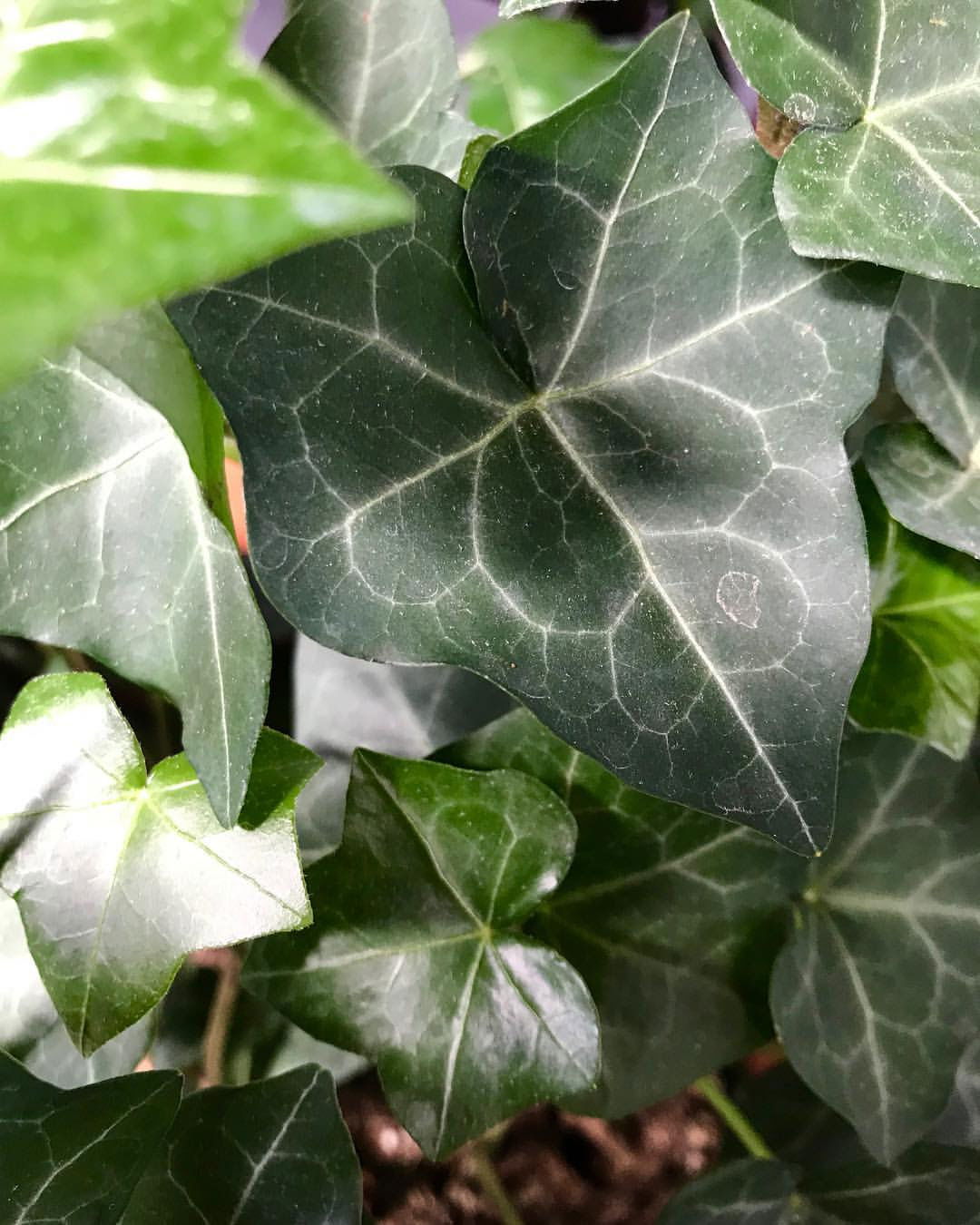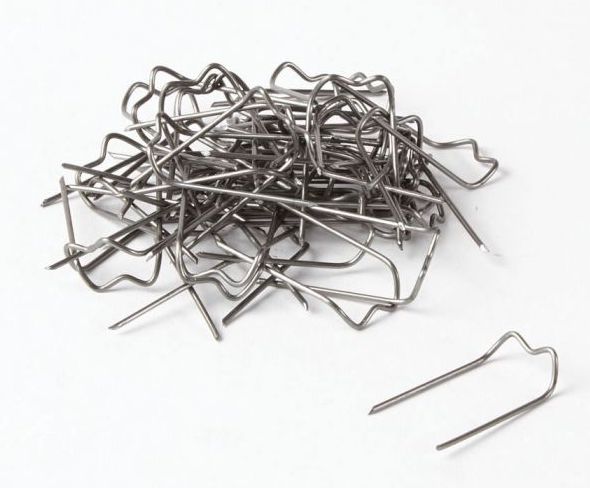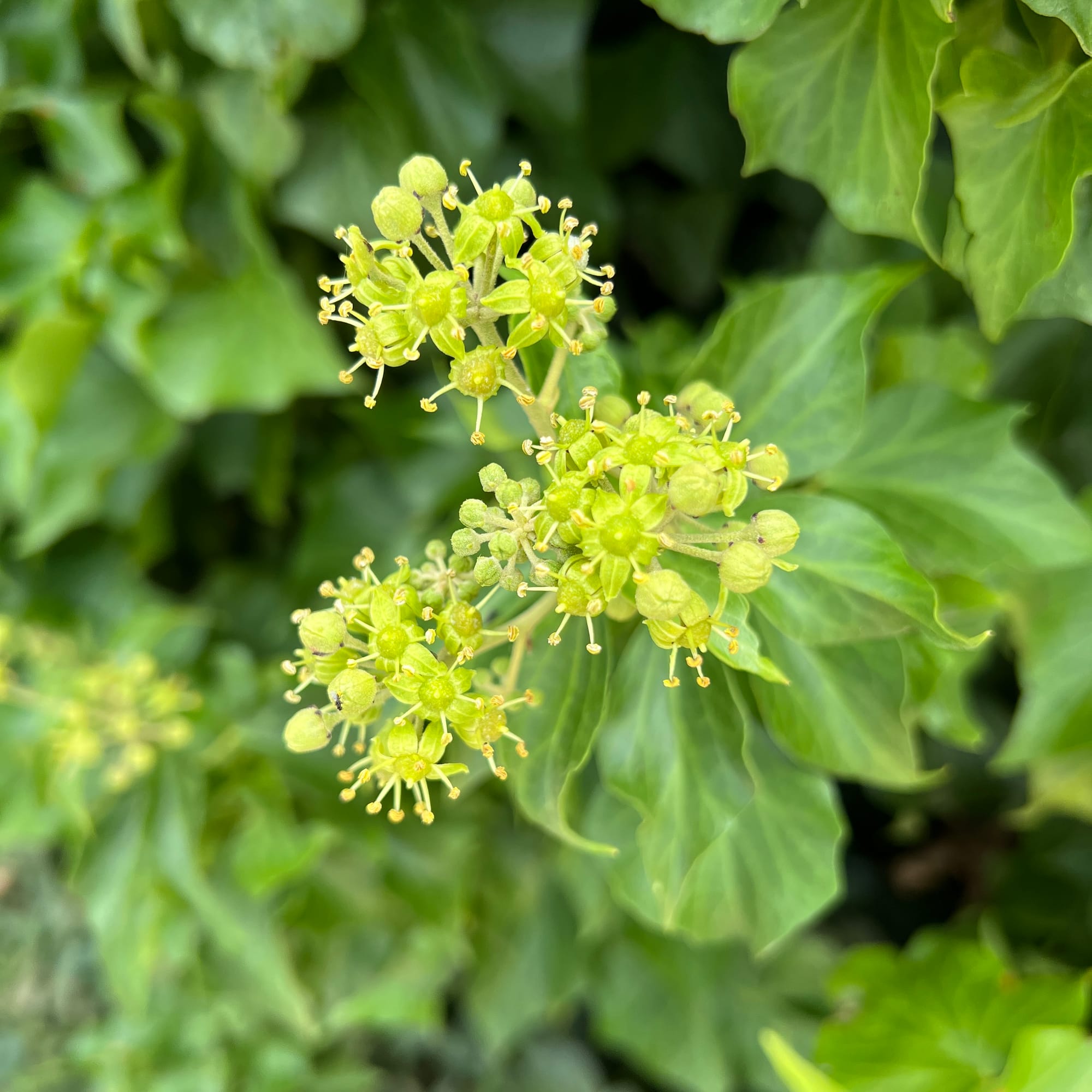
Hedera helix (Common English Ivy)
Contents
- Top Tips
- Location, Water, Humidity & Fertilisation
- Common Issues
- Origins, Temperature, Propagation, Repotting & Toxicity
Need the answer to a specific plant query? Book a 1-to-1 video call with THE HOUSEPLANT DOCTOR™, the website's friendly author, to overcome and address your niggling problem! Available on iMessage, WhatsApp, Facebook Messenger & more.
Top Tips & Info
- Care Difficulty - Moderate to Hard
- Keep the soil evenly moist at all times. Do not prolonged droughts due to the high risk of dehydration and death.
- Although average room humidity is acceptable, introduce a humidity tray to aid better growth.
- Bright indirect light is best, avoiding prolonged exposure to the sun, especially in the summer.
- Too-dark locations will cause variegations to fade on multi-coloured specimens. If it's bright enough to read a newspaper, you're good to go.
- Fertilise using a 'Houseplant' labelled feed every four waters in the spring and summer, reducing this to every six in the colder months.
- In spring, repot every three years with 'Houseplant' compost. Water the plant 24hrs beforehand, to reduce the risk of damaging the root hairs. (Transplant shock).
- Ivy grows quicker when there's something to grow up. Train the vines up a moss pole or trellis and loosely attach them with string - removing this string once the tendrils (suckers) supports the plant independently.
- According to NASA's 'Clean Air Study' in 1989, English Ivy has fantastic air-purifying properties. This species can absorb many airborne toxins including Benzene, Formaldehyde and even faecal matter from the atmosphere!
Location & Light - 🔸🔸
Bright indirect light is best. The combination of good soil moisture and a well-lit location will provide the best results for your Ivy. Sunny locations should be avoided at all costs. Prolonged exposure to the sun or dry soil will result in pale leaves, stunted growth and crisping foliage - if it's too hot for a chocolate bar, it'll be too hot for the plant, also.
Alternatively, lower-lit areas should only be used, if wholly necessary. Although English Ivy can thrive in shady locations, the reduced rates of photosynthesis and too moist soil will lead to a weakened plant, along with the chance of developing root rot. Variegated specimens situated in these areas will slowly revert back to its green appearance, too.
Water - 🔸🔸
Good soil moisture is essential for English Ivy due to their reduced ability to survive droughts. Once the top two inches dry out, rehydrate the soil using lukewarm water - their root systems can be sensitive to temperature change. Furthermore, splashing the leaves each time the plant is irrigated will cause the older leaves to rot. Under-watering symptoms include crispy/curling leaves, a grey, washed-out appearance, yellowing leaves and a lack of new growth. These issues are commonly down to either too much heat/light forgetfulness. Dehydration is the number one issue among English Ivy growers, so always keep an eye out for drying soil. Over-watering symptoms, on the other hand, include yellowing lower leaves, little to no growth and a rotting stem or leaves. Never allow Ivy to endure long periods of soggy soil or a dark location as both will significantly increase the chance of over-watering and death.
Read More - Identifying Common Houseplant Pests & Diseases
Humidity - 🔸🔸
Although providing a moist environment is vital, good air circulation is far more crucial for the plant's health. Introduce a humidity tray, especially in winter, to reduce the chances of browning leaf-tips. If it's situated in a darker location, be careful with over-misting; powdery mildew or leaf spot disease could arise at any time when the air circulation is poor.
Fertilisation - 🔸
Fertilise every four waters during the growing period before reducing this to every six in the autumn & winter. Although an 'All-Purpose' fertiliser will still do the job, we'd recommend using a specific 'Houseplant' labelled fertiliser as it'll support the vital thirteen nutrients that this species will need to grow.
Common Issues with English Ivy
Under-watering is the biggest issue. Typical signs of this include wilting, sunken and yellowed leaves and stunted growth. If the plant is in direct sunlight, relocate it to a slightly darker area. Increase the number of waters, too - Ivy tends to grow in moist soil that rarely promotes droughts. As long as you keep an eye out for drying soil, success is inevitable.
Those situated in direct sunlight or within three metres of a radiator are most likely to suffer from these issues.
Never situate English Ivy within four metres of an operating heat source, for instance, a radiator or fireplace. Due to the heightened temperature, the plant will soak up far more moisture than those situated in cooler locations, increasing the chance of droughts and browning leaf-edges.
Too much sunlight will lead to sun scorch, with typical signs including browning or crispy leaves, dry leaf-edges, sunken leaves or stunted growth. Although too little light will cause over-watering issues, too much sunlight will also be a detriment. If yours has fallen short of this, reduce the amount of sun considerably and always be mindful of environmental shock (when two locations offer too different growing conditions). Remove some of the affected leaves and increase waters slightly.
As mentioned before, powdery mildew and southern blight are major threats among heavy foliage plants when excess moisture is allowed to sit on compacted foliage. Remove the affected areas and improve the growing conditions by situating the plant in a brighter location and keeping the leaves dry.
A loss of variegations is caused by too little light. Although English Ivy can be used in shady locations, it'll come at the cost of the variegations. If you're not entirely bothered about this, simply skip this step. Move the plant into a brighter location to allow the variegations to re-develop on the new growth. Alternatively, extreme variegations that hinder the plant's green appearance is caused by too much sunlight.
Root rot is another common issue. Typical symptoms include rapidly yellowing leaves, stunted growth and stem collapse. Those situated in darker locations and/or too-soggy soil are most likely to be hit with this issue. Take the plant out of the pot and inspect its root systems - if they sport a yellow appearance, you're okay, but if they're brown and mushy, action must be taken immediately. More information about addressing root rot can be found on this link.
Pest damage can also cause issues down the line, with Spider Mites being the usual inhabitants. Check the under-leaves for their webs and near-transparent critters that are the size of a sand grain. Typical signs to look out for are mottled yellow leaves, stunted growth and sticky webs that'll hold bits of dirt. Click on this link for more info.
Additionally, small flies hovering around your plant or soil is entirely natural and may just indicate you're watering a little too often. Fungus Gnats are a common 'pest' with English Ivy due to their dependency to reliable soil moisture, but won't pose any risk to the plant's health. Simply replace the top quarter of the plant's potting mix for a fresh batch of 'Houseplant' labelled compost, typical found at most garden centres. Remember to reduce the frequency of waters to avoid this occurring again!
Too-low humidity will cause the browning of leaf tips with yellow halos, commonly caused by nearby operating radiators. As dry air is a big issue among households during the colder months, introducing a humidity/pebble tray will help deter this issue, along with providing better growth. Although this won't help with the already-affected leaves, its new growth will look as good as new. The use of artificial humidifiers is only needed while the radiators are operating.
If you're thinking of repotting a specimen that's growing up a moss pole, never remove the attached aerial roots as the disturbance could put further stress on the plant. Extend by purchasing another same-sized pole and pushing directly into the hollow hole in the original's top - its moss-like material may have to be cut off from the top to access the hollow centre. Get a long, sturdy stick that has a similar length to the two poles combined and place in the two's centre to support the weight. Always perform the repot BEFORE adding another pole, as it'll prove more challenging due to the weight distribution and overall balance. NEVER remove soil from the roots, or over-touch the root system, as this will cause transplant shock and possible death.
Yellowing lower leaves (closest to soil) is a clear sign of over-watering, usually caused by too little light. Although English Ivy can do well in darker locations, the frequency of irrigations must be reduced to counteract the chance of root rot. People don't realise that a plant's root system needs access to oxygen too, so when the soil is overly-saturated, the roots will suffocate and therefore will begin to breakdown. Click on this link to learn more about root rot and how to address it.
Origins
Hedera helix, or Common/English Ivy, is a perennial vine that originates from Eastern Europe, right up to Scotland and Ireland. Although the species was first described back in 1753 by Carl Linnaeus, historians can date back mentions of Ivy in the 17th century. Unfortunately, there is very little information regarding the origins of the name 'Hedera', but many believe it to be from Ancient Greek. The epithet, helix, is also from Ancient Greek, referring to the species' 'twisting' nature when climbing up structures or trees.
 The Distribution of Hedera helix.
The Distribution of Hedera helix.
Temperature
-5° - 30°C (23° - 86°F)
H3 (Hardiness Zone 9) - tolerate to temperatures below freezing. Although it can survive frosts and snow, refrain from bringing it indoors overnight if the room temperature is above 5℃ (40℉), as a sudden change in temperature may cause environmental shock with weakened spring growth and a lack of flowers over the season's course. Instead, either leave it outdoors or in an unheated conservatory, brightly lit garage or a greenhouse until the risk of frost has elapsed.
Spread
Up to 3m in height and width, when given a structure to climb up - the ultimate height will take between 3 - 6 years to achieve. Ivy that naturally grow in the wild can reach heights of up to fifteen metres; however, smaller root systems and less favourable growing conditions mean that they'll only grow to three metres.
Pruning & Maintenance
Remove yellow or dying leaves, and plant debris to encourage better-growing conditions. While pruning, always use clean utensils or shears to reduce the chance of bacterial and fungal diseases. Never cut through yellowed tissue as this may cause further damage in the likes of diseases or bacterial infections. Remember to make clean incisions as too-damaged wounds may shock the plant, causing weakened growth and a decline in health. Although the aerial roots aren't exactly appealing, do not remove them as this can stress the plant.
 Want to train yours up a moss pole? These 'Mossing Pins' are the perfect tool to keep your specimen growing the way it should!
Want to train yours up a moss pole? These 'Mossing Pins' are the perfect tool to keep your specimen growing the way it should!
Propagation
Via Seed or Stem & Eye Cuttings.
Stem & Eye Cuttings (Moderate) - This method of propagation is troublesome without the aid of bottom-heat and a controlled environment. Choose the healthiest, most established stems that are slightly hardened, yet still juvenile enough to bend slightly. Each cutting should only have ONE leaf and two nodes (one for the leaf and the other below for root development that'll be submerged in the soil). Cut directly below a node using a clean knife to reduce bacteria count. Situate the lower node into moist 'Houseplant' compost, with the only the leaf sticking out of the soil. 'Blackleg' can occur when the bottom wound becomes infected, typically caused by water-logging or a too-damaged wound. Maintain bright light and evenly moist soil with the avoidance of direct sunlight or cold draughts. Wrap the pot (& foliage) in a transparent bag or within a miniature greenhouse, and provide bottom heat of temperatures above 18°C (54°F). Remove the bag and place into individual 7cm pots once the second new leaf emerges. Follow the same care routines, as mentioned in the article's top half. This method will take up to five months, so patience and the correct environment are paramount for success!
 Here is an excellent example of a 'Stem & Eye' cutting that consists of two nodes and one leaf. The section below the red line should be submerged in the soil, keeping its foliage above ground to absorb airborne moisture.
Here is an excellent example of a 'Stem & Eye' cutting that consists of two nodes and one leaf. The section below the red line should be submerged in the soil, keeping its foliage above ground to absorb airborne moisture.
Flowers
English Ivy will produce small clusters of white flowers along the leading growths in the spring. Unfortunately, due to the unfavored growing conditions indoors, Ivy will rarely bloom when domestically cultivated.
 The flowers of Common English Ivy (Hedera helix)
The flowers of Common English Ivy (Hedera helix)
Repotting
Repot every three years in the spring, using a 'Houseplant' labelled compost and the next sized pot with adequate drainage. Hydrate the plant 24hrs before tinkering with the roots to prevent the risk of transplant shock. For those that are situated in a darker location, add a thin layer of small grit in the pot's base to improve drainage and downplay over-watering. Click here for a detailed step-by-step guide on transplantation, or via this link to learn about repotting with root rot.
Book a 1-to-1 video call with Joe Bagley if you'd like a personal guide to repotting your houseplant. This will include recommending the right branded-compost and pot size, followed by a live video call whilst you transplant the specimen for step-by-step guidance and answer any further questions!
Pests & Diseases
Keep an eye out for mealybugs, aphids, spider mites, scale, thrips, whitefly, blackfly, vine weevils & root mealybugs that'll locate themselves in the cubbyholes and undersides of the leaves, with the exception of the latter two in the soil. Common diseases associated with English Ivy are root rot, leaf-spot disease, botrytis, rust, powdery mildew & southern blight - click here to learn more about these issues.
Toxicity
This plant is classified as poisonous, so if small sections are eaten, vomiting, nausea and a loss of appetite may occur. Consumption of large quantities must be dealt with quickly; acquire medical assistance for further information.
Retail Locations
Blue Diamond, B&Q, Dobbies, IKEA, Homebase & Online Stores.
Book a 1-to-1 Call with THE HOUSEPLANT DOCTOR™
If you need further advice with your houseplants, book an advice call with ukhouseplants' friendly and expert writer today! This can be done via a video or audio call on most apps, including Facebook, FaceTime & Skype. A ten-minute call costs £5.99 (US$7), or £15.99 for thirty minutes. You can ask multiple questions, including queries on plants, pests, terrariums, repotting advice and anything in between. Please consider supporting this service to keep ukhouseplants thriving!